Influence of Base-Angle Bolt Support Parameters and Different Sections on Overall Stability of a Roadway under a Deeply Buried High Stress Environment Based on Numerical Simulation
Abstract
1. Introduction
2. Mechanism of Action of Base-Angle Bolt
2.1. Bolting Mechanism of the Base-Angle Bolt
2.2. Current Status of Base-Angle Bolt Applications in the China
3. Numerical Simulation Study of Different Cross-Sectional Roadway Profiles
3.1. Model Construction
3.2. Program Design
3.3. Simulation Results
4. Numerical Simulation Study of Engineering Examples
4.1. Overview of Roadway
4.2. Model Construction
4.3. Program Design
4.4. Simulation Results and Analysis
4.4.1. Angle
4.4.2. Length
5. Conclusions
Author Contributions
Funding
Institutional Review Board Statement
Informed Consent Statement
Data Availability Statement
Conflicts of Interest
References
- Zhao, X.; Zhou, X.; Zhao, Y.; Yu, W. Research Status and Progress of Prevention and Control of Mining Disasters in Deep Metal Mines. J. Cent. South Univ. Sci. Technol. 2021, 52, 2522–2538. [Google Scholar]
- Bai, J.; Hou, C.-J. Control Principle of Surrounding Rocks in Deep Roadway and Its Application. J.-China Univ. Min. Technol.-Chin. Ed. 2006, 35, 145. [Google Scholar]
- Shan, R.L.; Kong, X.S.; Yan, F.Y.; Meng, C. Research on Sidewall and Corner Strengthened Support for Coal Roadway by Modeling Experiments. Chin. J. Rock Mech. Eng. 2015, 34, 2336–2345. [Google Scholar]
- Shan, R.L.; Peng, Y.; Kong, Y.; Xiao, Y.; Yuan, B.; Zheng, Y. Research Progress of Coal Roadway Support Technology at Home and Abroad. Chin. J. Rock Mech. Eng. 2019, 38, 2377–2403. [Google Scholar]
- Kong, X.S.; Shan, R.L.; Ju, T.D. Model Experiment of Deformation and Failure Mechanism of Coal Roadway Surrounding Rock and Its Engineering Application. J. Min. Saf. Eng. 2017, 34, 464–471. [Google Scholar]
- Zheng, Y.; Shan, R.; Huang, B.; Feng, J.; Peng, R. Similar model tests on strong sidewall and corner support of gob side entry retaining. J. Min. Saf. Eng. 2021, 38, 94–102. [Google Scholar]
- Yang, S.; He, M.; Liu, W.; Ma, X. Mechanics and Application Research on The Floor Anchor to Control The Floor Heave of Deep Soft Rock Roadway. Chin. J. Rock Mech. Eng. 2008, 27, 2913–2920. [Google Scholar]
- Yang, J.; Shi, H.; Qi, G. Research on mechanism for floor heave control in the roadway by base-angel-bolt and its type selection test. J. Min. Saf. Eng. 2016, 33, 643–648. [Google Scholar]
- Liang, B.; Sun, H.; Li, G.; Wu, P. Genesis Analysis and Support Technology of Gob-side Entrydriving Floor Heave in Nanyangpo Coal Mine. Chin. J. Undergr. Space Eng. 2021, 17, 601–607. [Google Scholar]
- Dai, B.; Luo, X.; Shan, Q.; Chen, Y.; Liu, Y. Analysis on Damage Characteristics and Energy Dissipation of Rock with a Single Hole under Cyclic Impact Loads. China Saf. Sci. J. 2020, 30, 69. [Google Scholar]
- Dai, B.; Chen, Y. A Novel Approach for Predicting the Height of the Water-Flow Fracture Zone in Undersea Safety Mining. Remote Sens. 2020, 12, 358. [Google Scholar] [CrossRef]
- Dai, B.; Zhao, G.; Konietzky, H.; Wasantha, P.L.P. Experimental Investigation on Damage Evolution Behaviour of a Granitic Rock under Loading and Unloading. J. Cent. South Univ. 2018, 25, 1213–1225. [Google Scholar] [CrossRef]
- Dai, B.; Chen, Y.; Zhao, G.; Liang, W.; Wu, H. A Numerical Study on the Crack Development Behavior of Rock-Like Material Containing Two Intersecting Flaws. Mathematics 2019, 7, 1223. [Google Scholar] [CrossRef]
- Krykovskyi, O.; Krykovska, V.; Skipochka, S. Interaction of Rock-Bolt Supports While Weak Rock Reinforcing by Means of Injection Rock Bolts. Min. Min. Depos 2021, 15, 8–14. [Google Scholar] [CrossRef]
- Dyczko, A.; Kamiński, P.; Jarosz, J.; Rak, Z.; Jasiulek, D.; Sinka, T. Monitoring of Roof Bolting as an Element of the Project of the Introduction of Roof Bolting in Polish Coal Mines—Case Study. Energies 2022, 15, 95. [Google Scholar] [CrossRef]
- Małkowski, P.; Niedbalski, Z.; Majcherczyk, T.; Bednarek, Ł. Underground Monitoring as the Best Way of Roadways Support Design Validation in a Long Time Period. Min. Miner. Depos. 2020, 14, 1–14. [Google Scholar] [CrossRef]
- Das, R.; Singh, T.N. Effect of Rock Bolt Support Mechanism on Tunnel Deformation in Jointed Rockmass: A Numerical Approach. Undergr. Space 2021, 6, 409–420. [Google Scholar] [CrossRef]
- Esterhuizen, G.S.; Gearhart, D.F.; Klemetti, T.; Dougherty, H.; van Dyke, M. Analysis of Gateroad Stability at Two Longwall Mines Based on Field Monitoring Results and Numerical Model Analysis. Int. J. Min. Sci. Technol. 2019, 29, 35–43. [Google Scholar] [CrossRef]
- Ning, L. Study on Anchorage Mechanical Mechanism and Application of Rock Bolt in Composite Rock Mass. Chin. Univ. Min. Technol. 2021. [Google Scholar] [CrossRef]
- Liu, H.Y.; Zuo, J.P.; Liu, D.J.; Li, C.Y.; Xu, F.; Lei, B. Optimization of Roadway Bolt Support Based on Orthogonal Matrix Analysis. J. Min. Saf. Eng. 2021, 38, 84–93. [Google Scholar]
- Tian, J. Optimization of Support Design for Transport Channel of 3209 Working Face. Shandong Coal Sci. Technol. 2021, 39, 15–16. [Google Scholar]
- Guo, P.; Shen, D. Optimization design and numerical simulation of supporting scheme for deep mine roadway. Min. Saf. Envi. Prot. 2021, 48, 87–91. [Google Scholar]
- Shen, B.; Yuan, C.; Gu, W.; Liu, Z.; Song, T.; Pan, H. Research on the stability control of surrounding rock in the roadway with dynamic pressure and high slope. Ind. Mine Auto. 2021, 47, 50–55. [Google Scholar]
- Zhu, S.; Ding, K. Optimization of support parameters of water rich roadway based on thickness of grouting reinforce-ment circle. Saf. Coal Min. 2021, 52, 193–199+206. [Google Scholar]
- Zhao, W.; Fu, H.; Song, Y.; Ma, H.; Li, X. Failure Mechanism and Support Optimization of Sur-rounding Rock in Fault Crossing Roadway. Min. Res. Develop. 2021, 41, 129–134. [Google Scholar]
- Gao, L.; Deng, G.; Zhang, M.; Zhao, Q.; Ding, Y.; Zhang, E. Roadlway Surrounding Rock Control in Soft Rock Based on Theory of Composite Bolt-Rock Bearing Structure. Min. Res. Develop. 2021, 41, 140–144. [Google Scholar]
- Chang, L. Study on Timing Characteristics and Stability Control of Roadway Influences by Mining in High Stress Area. Taiyuan Univ. Technol. 2021. [Google Scholar] [CrossRef]
- Zhang, B.; Su, X.; Duan, Z.; Chang, L.; Fuzhou, W. Study on stability control of surrounding rock of roadway affected by driving disturbance. Min. Saf. Envir. Prot. 2020, 47, 19–24+31. [Google Scholar]
- Li, F. Anchor prestress field distribution characteristics and support optimization of multi type composite roof. Chin. Min. Mag. 2020, 29, 97–103. [Google Scholar]
- Zhai, Y. An Update of the 3D Analytical Solution for the Design of Barricades Made of Waste Rocks. Int. J. Rock Mech. Min. Sci. 2022, 158, 105176. [Google Scholar] [CrossRef]
- Cai, M.; Kaiser, P.K.; Morioka, H.; Minami, M.; Maejima, T.; Tasaka, Y.; Kurose, H. FLAC/PFC Coupled Numerical Simulation of AE in Large-Scale Underground Excavations. Int. J. Rock Mech. Min. Sci. 2007, 44, 550–564. [Google Scholar] [CrossRef]
- Skrzypkowski, K.; Zagórski, K.; Zagórska, A.; Apel, D.B.; Wang, J.; Xu, H.; Guo, L. Choice of the Arch Yielding Support for the Preparatory Roadway Located near the Fault. Energies 2022, 15, 3774. [Google Scholar] [CrossRef]
- Ma, S.-H.; Wang, W.-J. Comparative Analysis of Supporting Effect on Split-Set Bolt and GFRP Anchor Based on FLAC3D. Met. Mine 2012, 41, 9. [Google Scholar]
- Griffiths, D.V. Failure Criteria Interpretation Based on Mohr-Coulomb Friction. J. Geotech. Eng. 1990, 116, 986–999. [Google Scholar] [CrossRef]
- Hoek, E. Estimating Mohr-Coulomb Friction and Cohesion Values from the Hoek-Brown Failure Criterion. Int. J. Rock Mech. Min. Sci. Geomech. 1990, 27, 227–229. [Google Scholar] [CrossRef]
- Labuz, J.F.; Zang, A. Mohr–Coulomb Failure Criterion. Rock Mech. Rock Eng. 2012, 45, 975–979. [Google Scholar] [CrossRef]
- Dai, Y.; Chen, W.; Liu, Q.; Yi, X. Optimization Study on Cross Section of Deep Mine Tunnel under High in Situ Stress. Ch. Nese J. Rock Mech. Eng. 2004, 23, 4960–4965. [Google Scholar]
- Lü, A. Selection Method of Section Configuration of Underground Chamber in High Strata Stress Zone. J. China Coal Soc. 1997, 22, 495–498. [Google Scholar]
- Hou, M.Z.; Li, M.; Gou, Y.; Feng, W. Numerical Simulation and Evaluation of the Fracturing and Tight Gas Production with a New Dimensionless Fracture Conductivity (FCD) Model. Acta Geotech. 2021, 16, 985–1000. [Google Scholar] [CrossRef]
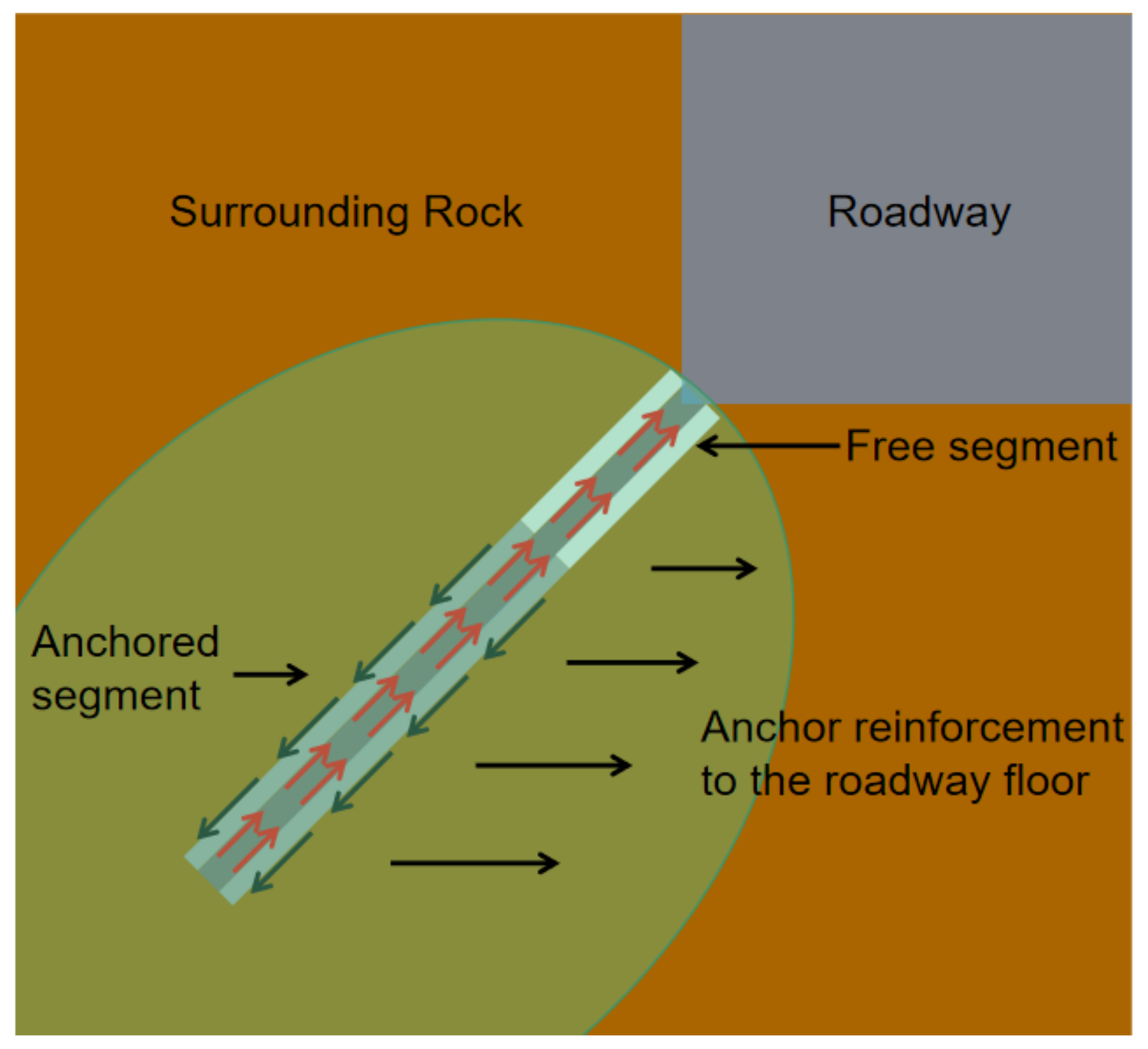
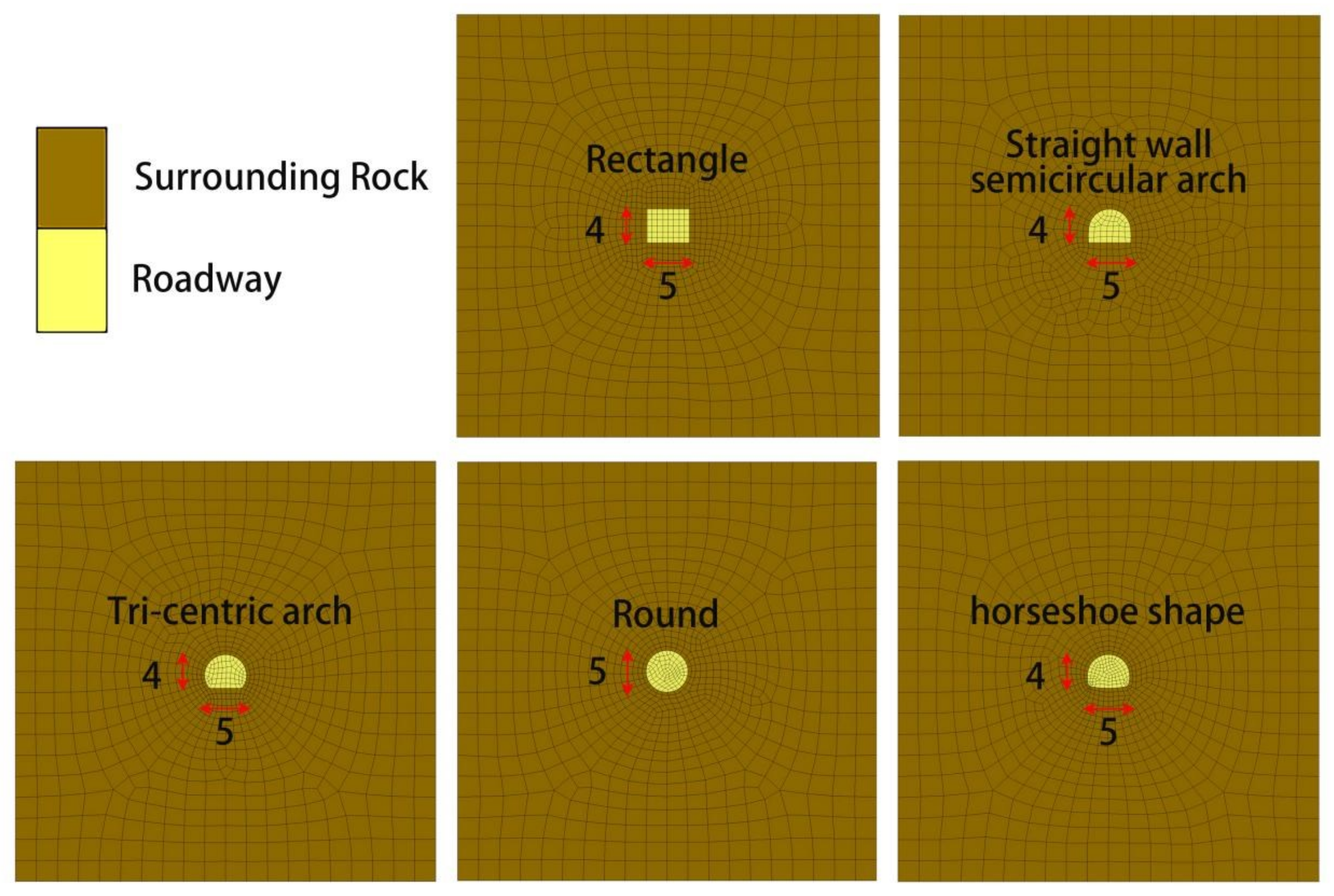
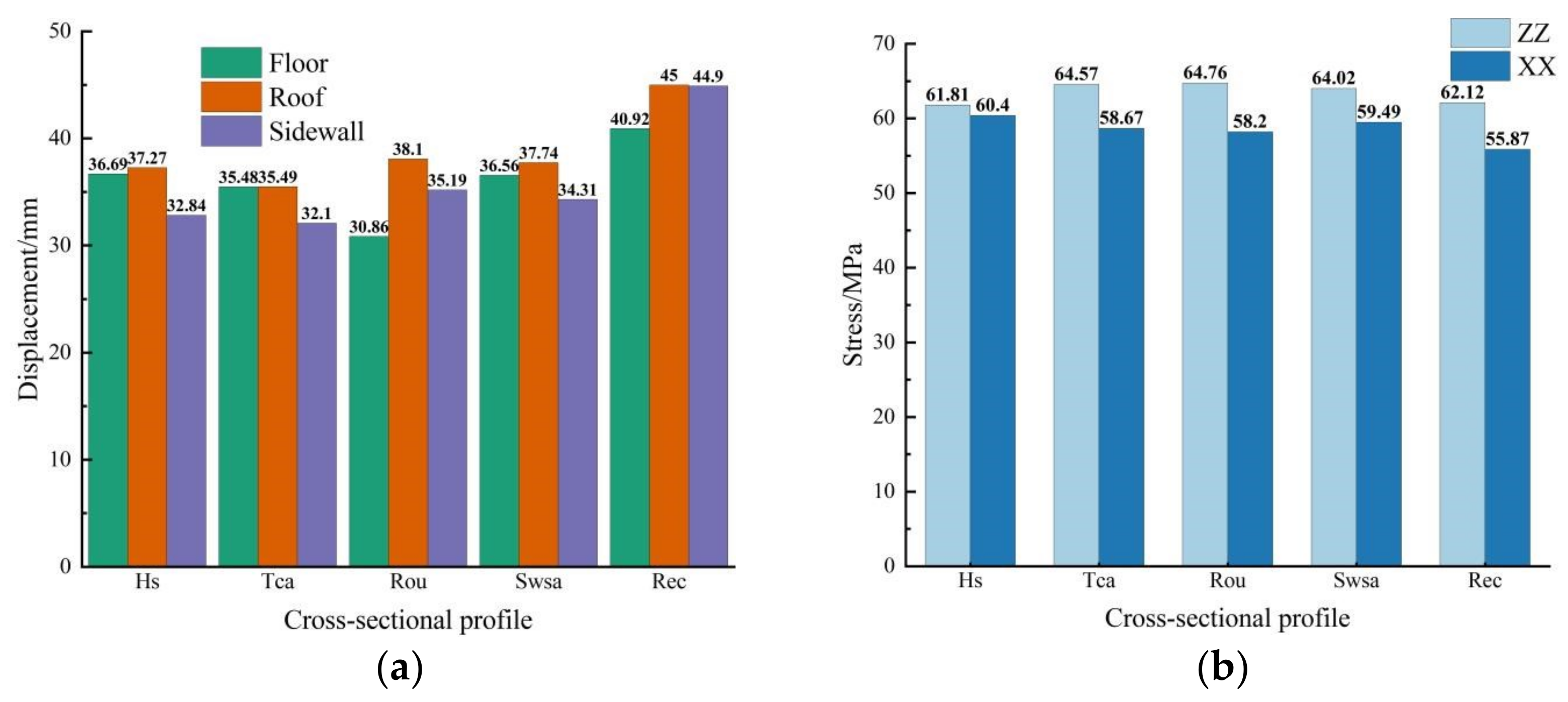

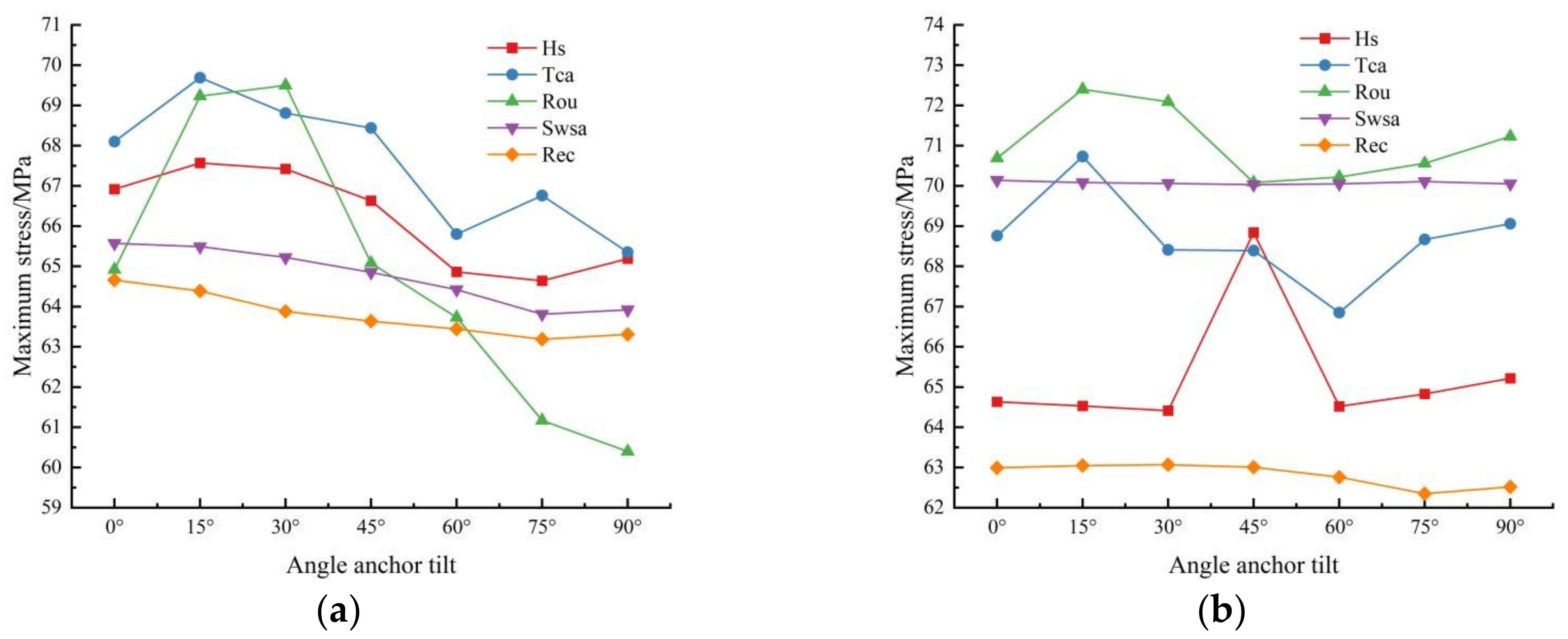
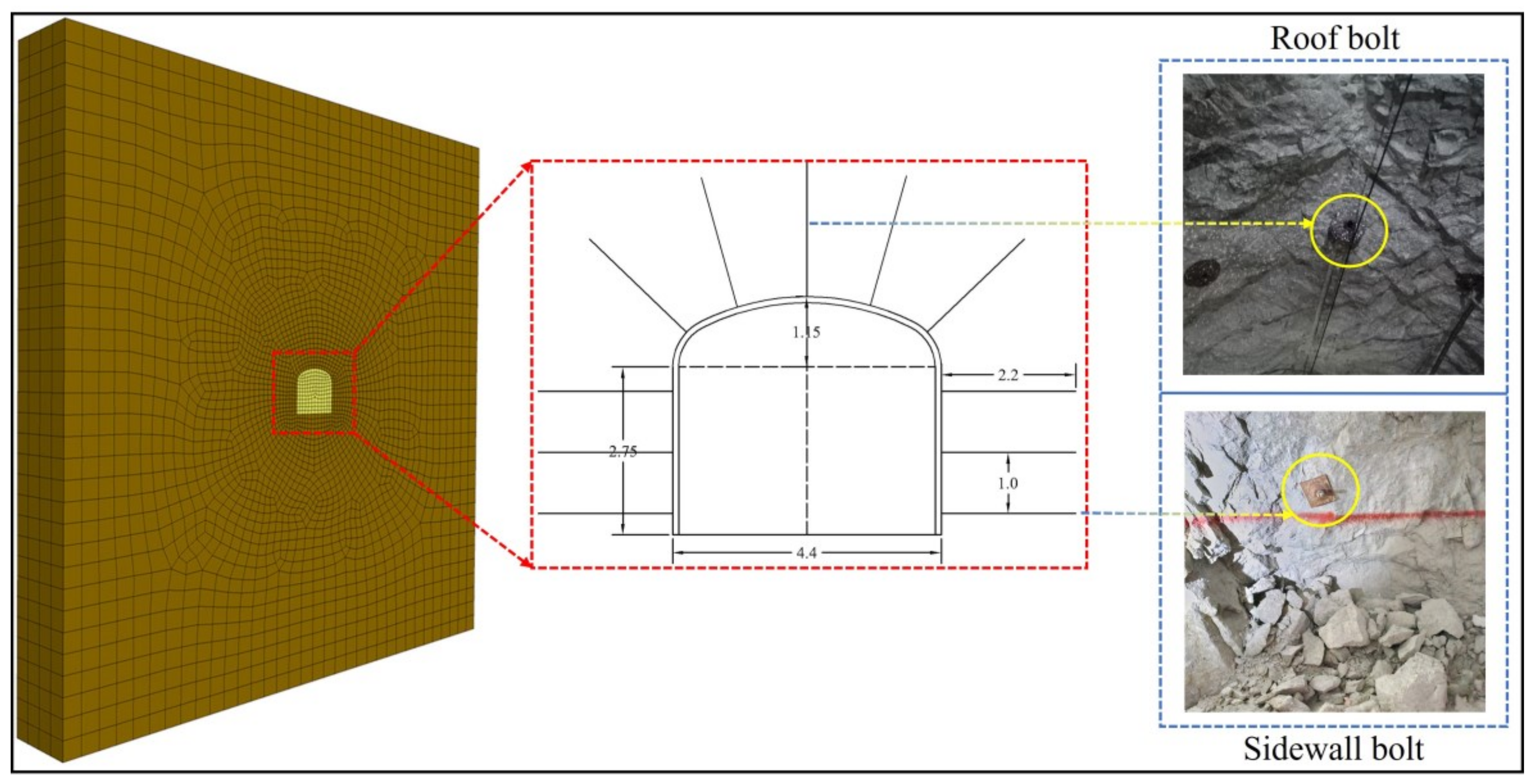



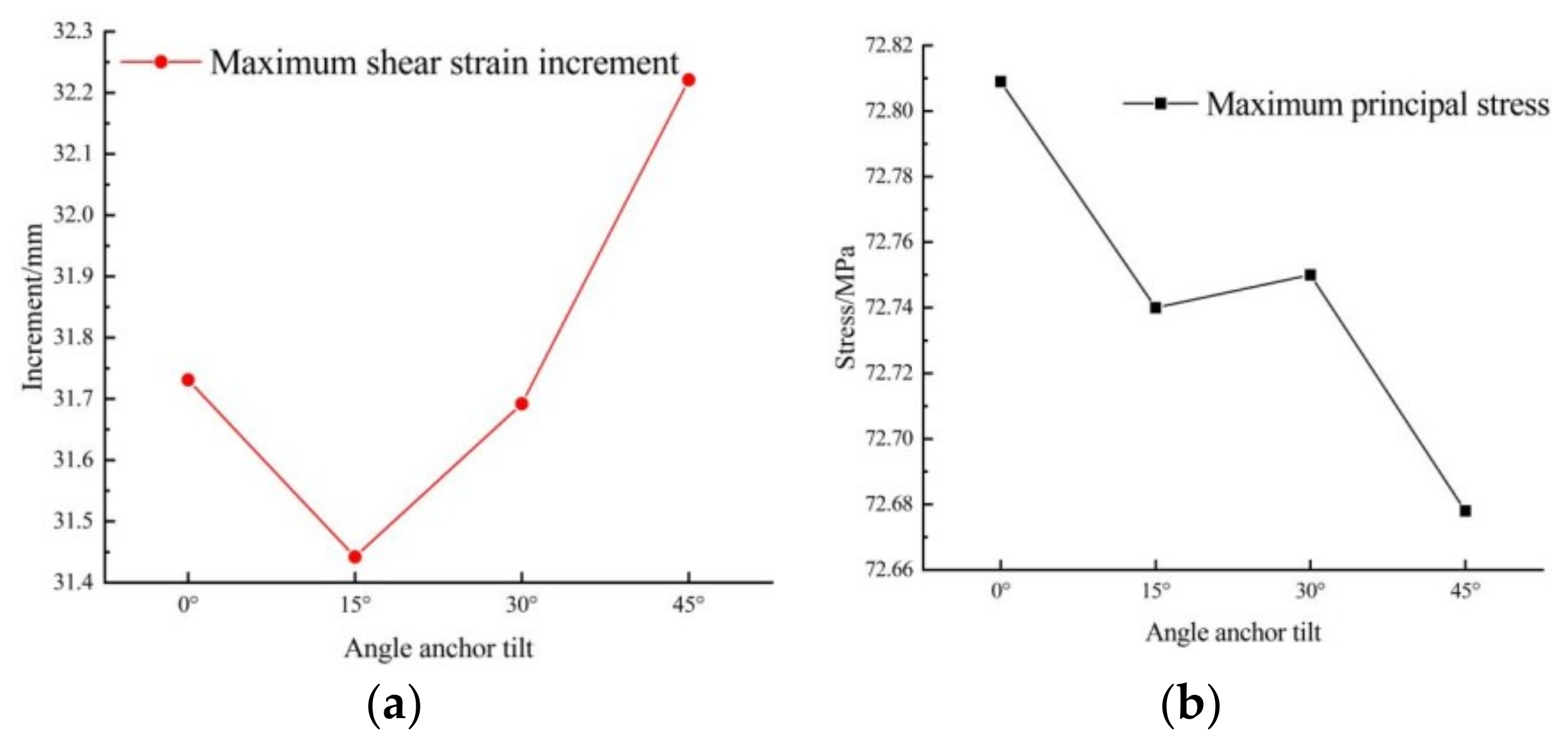

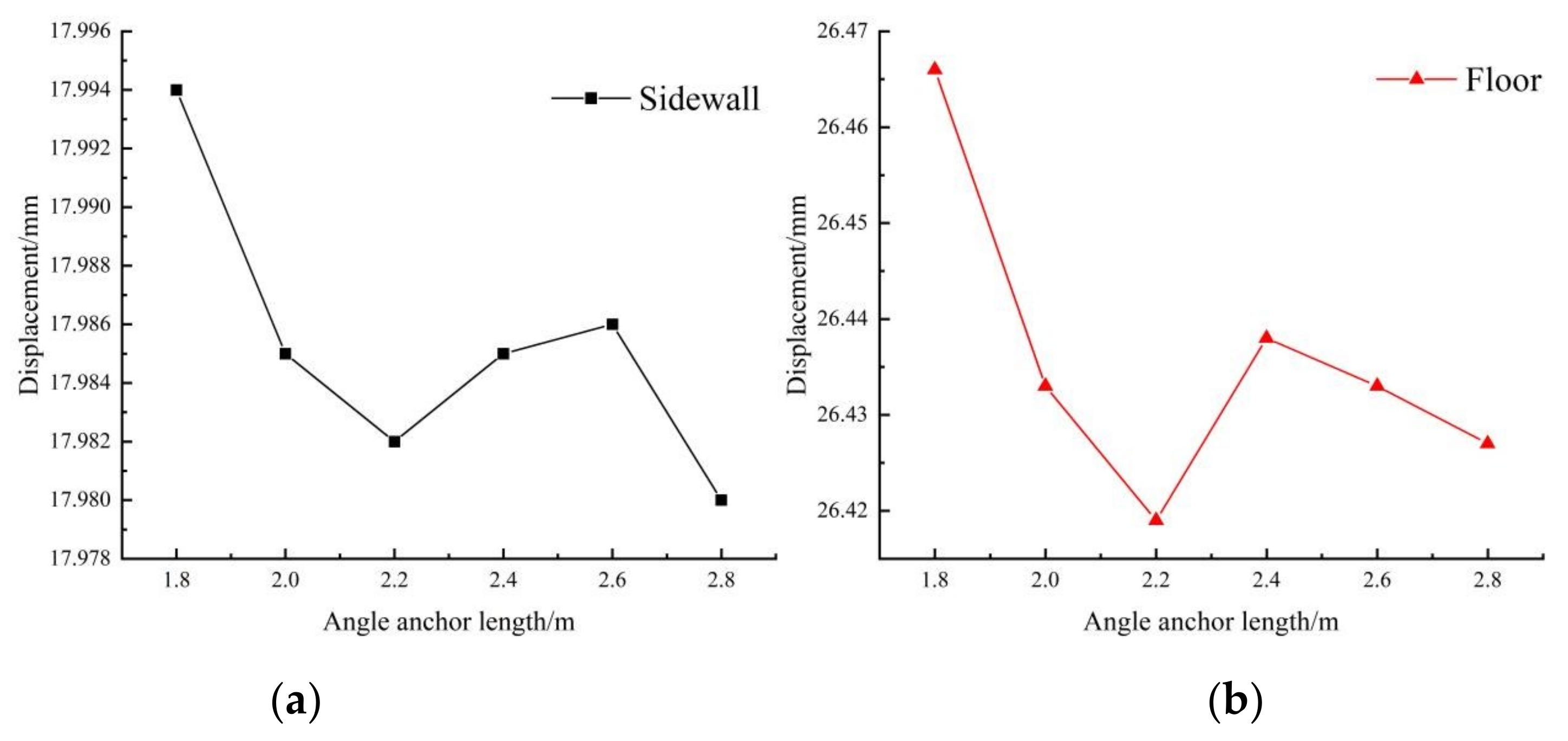
| Mines | Cross-Sectional Profile | Depth of Burial/m | Inclined Angle of the Bolt at the Bottom of the Side Wall/° | Yes or No Base-Angle Bolt |
|---|---|---|---|---|
| Wangpo Coal Mine, 3209 working faces | Rectangular | 450 | 5–15 | No |
| Songzao Coal and Electricity Company’s Datong I Mine, | Straight wall, rounded arch | 500 | 15 | No |
| 15,312 working faces in a coal mine | Rectangular | 240–300 | 0 | No |
| Taoyuan Coal Mine II Mining Area | Straight wall, rounded arch | 518–799 | 30 | No |
| A coal mine pump room substation roadway | Straight wall, rounded arch | 850 | 15 | No |
| 21,126 Haulage Lane, Panjiang Hengpu Coal Industry, Guizhou | Straight wall, rounded arch | - | 10 | Yes |
| 3316 working faces at Shuangliu Coal Mine | Rectangular | 600 | 0 | No |
| 3# coal seam in a coal mine | Rectangular | 453 | 0 | No |
| Longquan Coal Mine tape tunnel | Rectangular | 600 | 15 | No |
| Yangquan Mine, Shang She Mine, Yangquan District, 9304 intake road | Rectangular | 230–270 | 0 | No |
| Bulk Modulus K/GPa | Shear Modulus K/GPa | Cohesion C/MPa | Internal Friction Angle ψ/(°) | Density γ/(t/m3) | Tensile Strength σt/MPa |
|---|---|---|---|---|---|
| 10 | 6 | 2 | 30 | 2.6 | 1 |
| Type | Inclined Angle/° | Type | Inclined Angle/° | Type | Inclined Angle/° | Type | Inclined Angle/° | Type | Inclined Angle/° |
|---|---|---|---|---|---|---|---|---|---|
| Rec | 0 | Hs | 0 | Tca | 0 | Rou | 0 | Swsa | 0 |
| Rec | 15 | Hs | 15 | Tca | 15 | Rou | 15 | Swsa | 15 |
| Rec | 30 | Hs | 30 | Tca | 30 | Rou | 30 | Swsa | 30 |
| Rec | 45 | Hs | 45 | Tca | 45 | Rou | 45 | Swsa | 45 |
| Rec | 60 | Hs | 60 | Tca | 60 | Rou | 60 | Swsa | 60 |
| Rec | 75 | Hs | 75 | Tca | 75 | Rou | 75 | Swsa | 75 |
| Rec | 90 | Hs | 90 | Tca | 90 | Rou | 90 | Swsa | 90 |
| Rec | Hs | Tca | Rou | Swsa |
|---|---|---|---|---|
 |  |  |  |  |
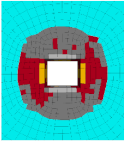 | 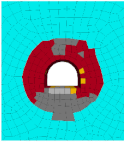 | 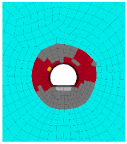 | 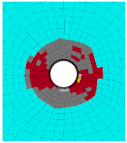 | 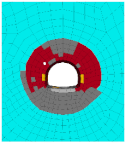 |
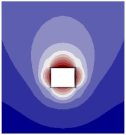 |  |  |  |  |
 |  |  |  |  |
 |  | 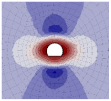 |  |  |
| Bulk Modulus K/GPa | Shear Modulus K/GPa | Cohesion C/MPa | Poisson’s Ratio υ | Internal Friction Angle ψ/° | Density γ/(t/m3) | Tensile Strength σt/MPa |
|---|---|---|---|---|---|---|
| 21.08 | 9.73 | 4.0 | 0.3 | 30 | 2.67 | 1.53 |
| Cumulative Shear Strain Increment | 0 | 0.01 | 0.1 | 1 |
|---|---|---|---|---|
| Internal friction angle/° | 30 | 27 | 22 | 20 |
| Cohesion/MPa | 4 | 2 | 0.5 | 0.1 |
| Shear expansion angle/° | 10 | 2 | 0 | 0 |
| Program | No. | Inclined Angle of Base-Angle Bolt | Length of Base- Angle Bolt | Program | No. | Inclined Angle of Base-Angle Bolt | Length of Base-Angle Bolt |
|---|---|---|---|---|---|---|---|
| Unsupported | 1 | - | - | Optimization of support (length) | 6 | 15 | 1.8 |
| 7 | 15 | 2.0 | |||||
| Optimization of support (angle) | 2 | 0 | 2.2 | 8 | 15 | 2.2 | |
| 3 | 15 | 2.2 | 9 | 15 | 2.4 | ||
| 4 | 30 | 2.2 | 9 | 15 | 2.6 | ||
| 5 | 45 | 2.2 | 10 | 15 | 2.8 |
| Unsupported | 15° | Description | ||
|---|---|---|---|---|
 | 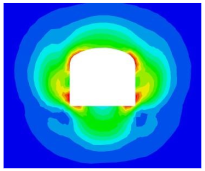 | 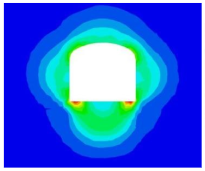 |  | The maximum shear strain increase without support is mainly concentrated at the four gang corners of the roadway; after support, it is concentrated at the bottom gang corners, and the value increases by 0.68. |
| a. Maximum shear strain increment | ||||
 | 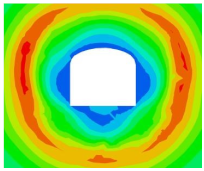 |  |  | Without support, the maximum shear stress is distributed in a circular pattern around the roadway; with support, the maximum shear stress area is closer to the roadway and is 1.21 MPa lower than without support. |
| b. Maximum shear stress(Pa) | ||||
 | 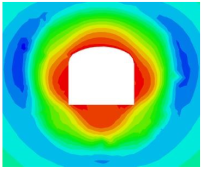 |  |  | The maximum principal stresses are located on both sidewalls of the roadway when there is no support; after the support, some of the maximum principal stresses are transferred to the upper and lower sidewalls and are 4.99 MPa lower than when there is no support. |
| c. Maximum principal stress(Pa) | ||||
Disclaimer/Publisher’s Note: The statements, opinions and data contained in all publications are solely those of the individual author(s) and contributor(s) and not of MDPI and/or the editor(s). MDPI and/or the editor(s) disclaim responsibility for any injury to people or property resulting from any ideas, methods, instructions or products referred to in the content. |
© 2023 by the authors. Licensee MDPI, Basel, Switzerland. This article is an open access article distributed under the terms and conditions of the Creative Commons Attribution (CC BY) license (https://creativecommons.org/licenses/by/4.0/).
Share and Cite
Wu, Q.; Liu, H.; Dai, B.; Cheng, L.; Li, D.; Qin, P. Influence of Base-Angle Bolt Support Parameters and Different Sections on Overall Stability of a Roadway under a Deeply Buried High Stress Environment Based on Numerical Simulation. Sustainability 2023, 15, 2496. https://doi.org/10.3390/su15032496
Wu Q, Liu H, Dai B, Cheng L, Li D, Qin P. Influence of Base-Angle Bolt Support Parameters and Different Sections on Overall Stability of a Roadway under a Deeply Buried High Stress Environment Based on Numerical Simulation. Sustainability. 2023; 15(3):2496. https://doi.org/10.3390/su15032496
Chicago/Turabian StyleWu, Qinzheng, Huanxin Liu, Bing Dai, Li Cheng, Danli Li, and Penghui Qin. 2023. "Influence of Base-Angle Bolt Support Parameters and Different Sections on Overall Stability of a Roadway under a Deeply Buried High Stress Environment Based on Numerical Simulation" Sustainability 15, no. 3: 2496. https://doi.org/10.3390/su15032496
APA StyleWu, Q., Liu, H., Dai, B., Cheng, L., Li, D., & Qin, P. (2023). Influence of Base-Angle Bolt Support Parameters and Different Sections on Overall Stability of a Roadway under a Deeply Buried High Stress Environment Based on Numerical Simulation. Sustainability, 15(3), 2496. https://doi.org/10.3390/su15032496






